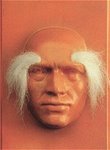
You may recall that the previous post left an impression that seven years of professional poker had left me embittered, sarcastic and with blood on my hands. Well, this latest post will do little to disabuse you of that but, for the record, I would like to state that the goat was suffering from terminal acrophobia and was becoming a nuisance in my study. It was what he would have wanted, had he been capable of lateral thought. May he baste in grease.
Anyway, today’s offering will deal with the much-loved heart stopping moment that is the flop. I like to compare it to seeing the front page of a daily newspaper: sometimes those three little cards make you feel like have seen an image of yourself scoring trophy-winning points for your local team; other times, it is like discovering that your dad has been caught in a sting and he’s partial to sadomasochism.
To play Hold 'em is to experience pain and pleasure and the flop shines the biggest light on who is likely to have the whip hand. Your job is to distinguish whether the bulb is green or red. Unfortunately some players are so blinded by the quality of their hole cards that they are unable to assess the impact of the flop. It is a handicap that can leave them stumbling around with a begging cup.
It can be eye opening to remember that if pocket aces find themselves against just three opponents (assuming live cards) the bullets will misfire over four times in ten. Those stats are pre-flop. Afterwards, if two of the players hit a pair, your odds dip extremely close to even money.
I’m not advocating that you should muck your hand (you are still ahead) but some players gripe when their aces are cracked in these scenarios. They forget how often AA loses. They don’t study the flop.
If you want to feast on the table’s chips, you have to remember that your hole cards are a mere entree: the flop is where the carving happens.


No comments:
Post a Comment